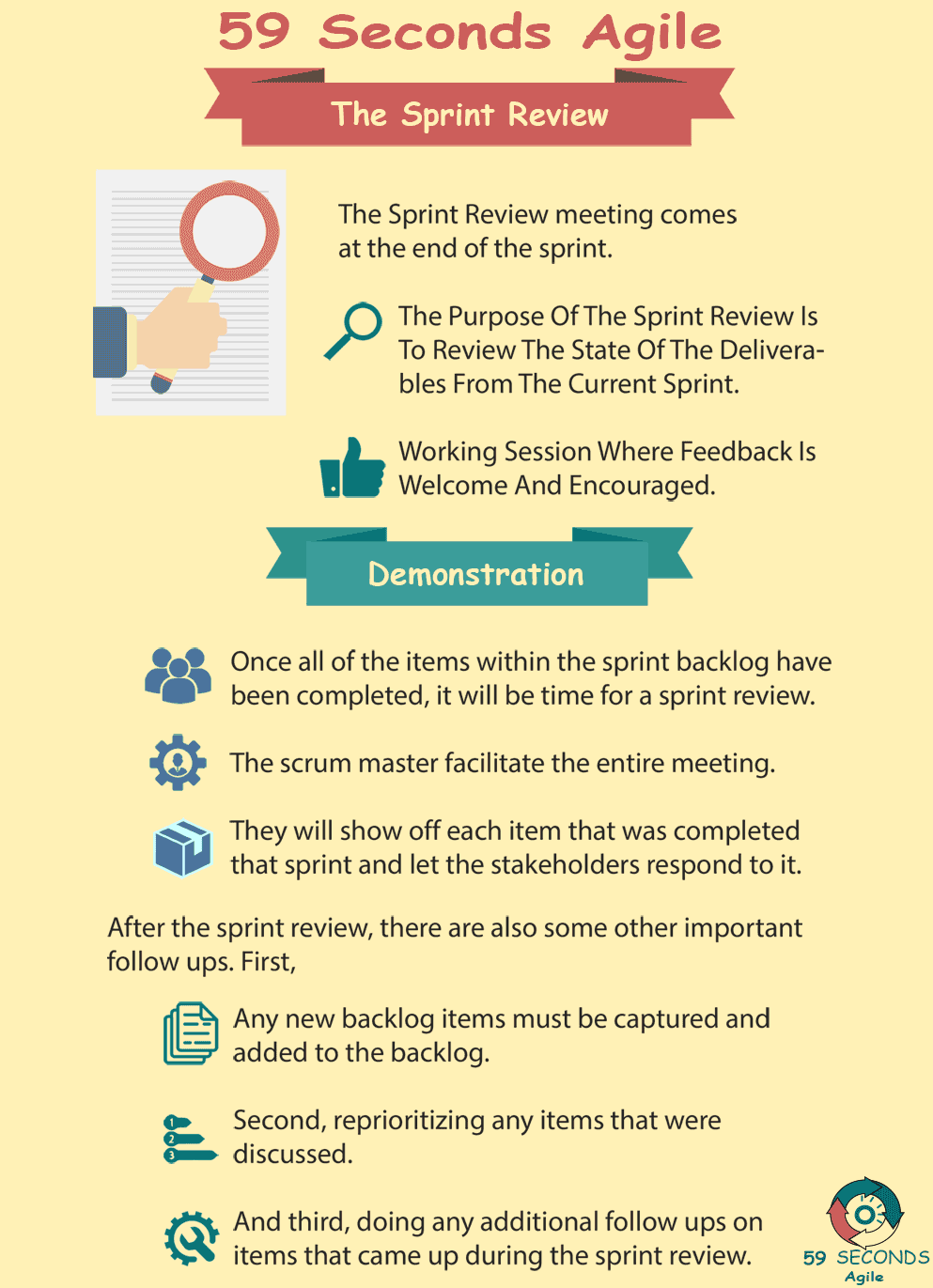What is the Agile Sprint Review Meeting and what role do the Development Team plan within this meeting? The developers play an important role in the Scrum Meeting.
Sprint Review Meeting
A 59 Seconds Agile Video Animation
The Sprint Review Meeting for Developers?
A 59 Seconds Agile Article
In Agile software development, the Sprint Review Meeting is a demonstration meeting held at the end of every sprint. In it, the Scrum team showcases new features finished in the sprint. To some, this may seem excessive or unnecessary. Why have a meeting after every sprint when you can just have one big meeting at the end of the project? However, having a meeting at the end of every sprint yields several benefits.
Sprint Review Meeting: The Benefits
The biggest benefit of the sprint review meeting is that it keeps all parties informed. Even roles who did not directly work on the project get regular updates. Stakeholders see features in action, within weeks after they are finished. Instead of going months or even years without new features, they see the fruits of new development often. In turn, developers and other scrum team roles see stakeholder reaction to their hard work. This can help steer future development.
Similarly, the meeting offers an open forum for questions. Not only are stakeholders allowed to give feedback, they are encouraged. If they like or dislike features, or need clarification on how something works, they can voice these concerns. The scrum team then sees where they may need to explain things better, or how to change development moving forward.
Sprint Review Meeting: Roles in the Meeting
Most people consider the product owner the key role of the sprint review meeting. For most parts of the meeting, the product owner is the role who approves or rejects the sprint deliverables. Product owners are responsible for interacting with stakeholders, and the most important purpose of the meeting is to show the stakeholders what new features are in the product. No other roles of a scrum team have customer-facing responsibilities.
On the communication front, Scrum Masters would also have a responsibility in the sprint review meeting. The Scrum Master is typically in charge of coordinating different roles and guiding the Agile development process. As such, it would be up to the Scrum Master to make sure everyone on the team is informed.
Developer Responsibility
So what part do developers have in the sprint review meeting? It would make sense for developers’ work to be done before the meeting. New development is done, and features have been tested if they are to be shown at the meeting. The meeting is just demonstrating what the scrum team accomplished. The developer role offers value to the meeting, most notably, developers have the expertise to answer technical questions. They know what goes on under the surface with a product. If stakeholders have questions that other roles cannot answer, developers should know the details.
Along with explaining details, developers can assuage concerns. If stakeholders are worried about vulnerabilities, developers can explain what security measure is in place to prevent them. If concerns are impossible or unlikely to happen, developers can elaborate on why. On the occasion that stakeholders do bring up valid concerns, developers have the opportunity to explain how it will be addressed moving forward.
Sprint Review Meeting: Developer Benefit
The biggest benefit that developers stand to gain from the meeting is first-hand exposure to stakeholders. This is especially true with accepting or rejecting deliverables. One of the biggest problems with traditional development is how feedback gets filtered through different people. Customers respond to marketing employees, who send this information down the pipe to developers. By the time developers hear the information, it may have lost the majority of its original meaning. This watered down summary is rarely helpful to developers. How can they make productive changes when they don’t really know what the customers wanted?
Prev <— Continue Reading —> Next
Learn More: Agile Sprint Review and Retrospective
User Stories Applied
A 59 Seconds Agile Book Review
User Stories Applied by Mike Cohn is one of our favourite books on Agile User Stories. The book starts with an overview into user stories, and details what a user story is and the different aspects of them. He then discusses how to go about writing a user story, and provides details of the INVEST criteria that can be used to determine if the story is meeting all of its objectives. Next Mike gives an in depth discussion of who user stories are written for and where to begin when gathering the details for them. The book then discusses acceptance testing user stories, including how to go about specifying these criteria and the responsibilities of the development team and customers during this process.
Prev <— Continue Reading —> Next
Learn More: Agile Sprint Review and Retrospective
Agile Sprint Review and Retrospective
A 59 Seconds Agile Infographic

Prev <— Continue Reading —> Next
Learn More: Agile Sprint Review and Retrospective
Prev <— Continue Reading —> Next
Learn More: Agile Sprint Review and Retrospective
Our Favourite Agile Books
We found these books great for finding out more information on Agile Scrum:

